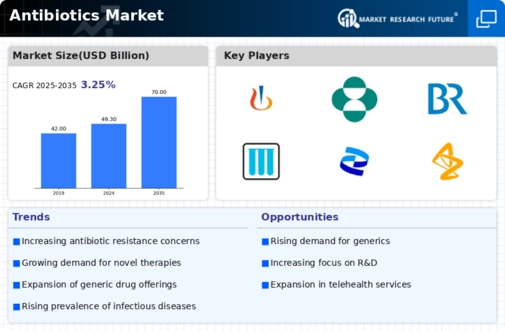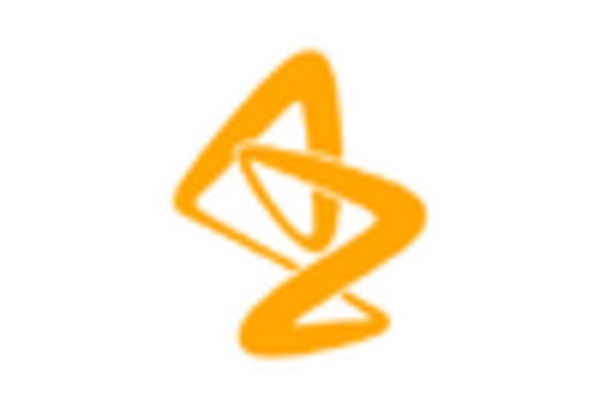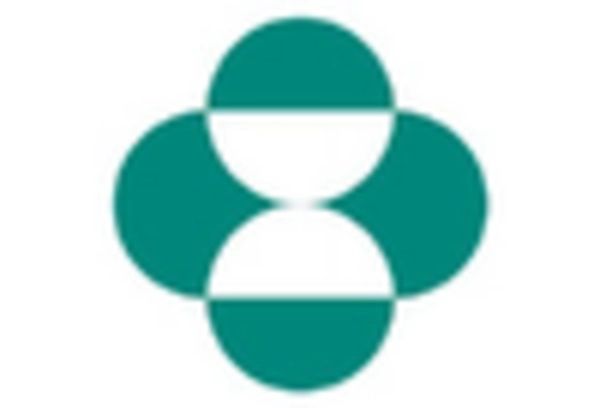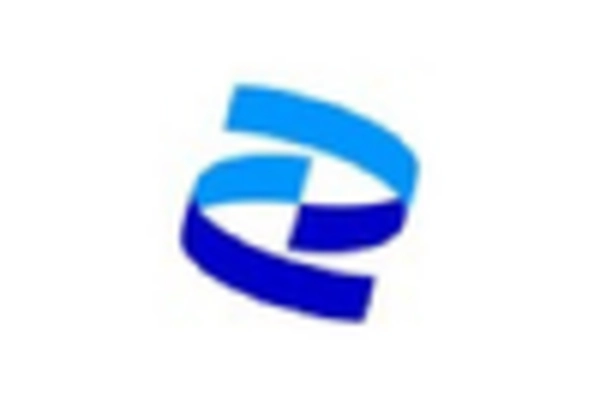Penicillins
Cephalosporins
Macrolides
Tetracyclines
Aminoglycosides
Oral
Intravenous
Intramuscular
Topical
Infectious Diseases
Prophylaxis
Surgery
Cancer Treatment
Hospitals
Clinics
Homecare
Pharmaceutical Laboratories
North America
Europe
South America
Asia Pacific
Middle East and Africa
North America Outlook (USD Billion, 2019-2035)
North America Antibiotics Market by Type
Penicillins
Cephalosporins
Macrolides
Tetracyclines
Aminoglycosides
North America Antibiotics Market by Route of Administration Type
Oral
Intravenous
Intramuscular
Topical
North America Antibiotics Market by Application Type
Infectious Diseases
Prophylaxis
Surgery
Cancer Treatment
North America Antibiotics Market by End User Type
Hospitals
Clinics
Homecare
Pharmaceutical Laboratories
North America Antibiotics Market by Regional Type
US
Canada
US Outlook (USD Billion, 2019-2035)
US Antibiotics Market by Type
Penicillins
Cephalosporins
Macrolides
Tetracyclines
Aminoglycosides
US Antibiotics Market by Route of Administration Type
Oral
Intravenous
Intramuscular
Topical
US Antibiotics Market by Application Type
Infectious Diseases
Prophylaxis
Surgery
Cancer Treatment
US Antibiotics Market by End User Type
Hospitals
Clinics
Homecare
Pharmaceutical Laboratories
CANADA Outlook (USD Billion, 2019-2035)
CANADA Antibiotics Market by Type
Penicillins
Cephalosporins
Macrolides
Tetracyclines
Aminoglycosides
CANADA Antibiotics Market by Route of Administration Type
Oral
Intravenous
Intramuscular
Topical
CANADA Antibiotics Market by Application Type
Infectious Diseases
Prophylaxis
Surgery
Cancer Treatment
CANADA Antibiotics Market by End User Type
Hospitals
Clinics
Homecare
Pharmaceutical Laboratories
Europe Outlook (USD Billion, 2019-2035)
Europe Antibiotics Market by Type
Penicillins
Cephalosporins
Macrolides
Tetracyclines
Aminoglycosides
Europe Antibiotics Market by Route of Administration Type
Oral
Intravenous
Intramuscular
Topical
Europe Antibiotics Market by Application Type
Infectious Diseases
Prophylaxis
Surgery
Cancer Treatment
Europe Antibiotics Market by End User Type
Hospitals
Clinics
Homecare
Pharmaceutical Laboratories
Europe Antibiotics Market by Regional Type
Germany
UK
France
Russia
Italy
Spain
Rest of Europe
GERMANY Outlook (USD Billion, 2019-2035)
GERMANY Antibiotics Market by Type
Penicillins
Cephalosporins
Macrolides
Tetracyclines
Aminoglycosides
GERMANY Antibiotics Market by Route of Administration Type
Oral
Intravenous
Intramuscular
Topical
GERMANY Antibiotics Market by Application Type
Infectious Diseases
Prophylaxis
Surgery
Cancer Treatment
GERMANY Antibiotics Market by End User Type
Hospitals
Clinics
Homecare
Pharmaceutical Laboratories
UK Outlook (USD Billion, 2019-2035)
UK Antibiotics Market by Type
Penicillins
Cephalosporins
Macrolides
Tetracyclines
Aminoglycosides
UK Antibiotics Market by Route of Administration Type
Oral
Intravenous
Intramuscular
Topical
UK Antibiotics Market by Application Type
Infectious Diseases
Prophylaxis
Surgery
Cancer Treatment
UK Antibiotics Market by End User Type
Hospitals
Clinics
Homecare
Pharmaceutical Laboratories
FRANCE Outlook (USD Billion, 2019-2035)
FRANCE Antibiotics Market by Type
Penicillins
Cephalosporins
Macrolides
Tetracyclines
Aminoglycosides
FRANCE Antibiotics Market by Route of Administration Type
Oral
Intravenous
Intramuscular
Topical
FRANCE Antibiotics Market by Application Type
Infectious Diseases
Prophylaxis
Surgery
Cancer Treatment
FRANCE Antibiotics Market by End User Type
Hospitals
Clinics
Homecare
Pharmaceutical Laboratories
RUSSIA Outlook (USD Billion, 2019-2035)
RUSSIA Antibiotics Market by Type
Penicillins
Cephalosporins
Macrolides
Tetracyclines
Aminoglycosides
RUSSIA Antibiotics Market by Route of Administration Type
Oral
Intravenous
Intramuscular
Topical
RUSSIA Antibiotics Market by Application Type
Infectious Diseases
Prophylaxis
Surgery
Cancer Treatment
RUSSIA Antibiotics Market by End User Type
Hospitals
Clinics
Homecare
Pharmaceutical Laboratories
ITALY Outlook (USD Billion, 2019-2035)
ITALY Antibiotics Market by Type
Penicillins
Cephalosporins
Macrolides
Tetracyclines
Aminoglycosides
ITALY Antibiotics Market by Route of Administration Type
Oral
Intravenous
Intramuscular
Topical
ITALY Antibiotics Market by Application Type
Infectious Diseases
Prophylaxis
Surgery
Cancer Treatment
ITALY Antibiotics Market by End User Type
Hospitals
Clinics
Homecare
Pharmaceutical Laboratories
SPAIN Outlook (USD Billion, 2019-2035)
SPAIN Antibiotics Market by Type
Penicillins
Cephalosporins
Macrolides
Tetracyclines
Aminoglycosides
SPAIN Antibiotics Market by Route of Administration Type
Oral
Intravenous
Intramuscular
Topical
SPAIN Antibiotics Market by Application Type
Infectious Diseases
Prophylaxis
Surgery
Cancer Treatment
SPAIN Antibiotics Market by End User Type
Hospitals
Clinics
Homecare
Pharmaceutical Laboratories
REST OF EUROPE Outlook (USD Billion, 2019-2035)
REST OF EUROPE Antibiotics Market by Type
Penicillins
Cephalosporins
Macrolides
Tetracyclines
Aminoglycosides
REST OF EUROPE Antibiotics Market by Route of Administration Type
Oral
Intravenous
Intramuscular
Topical
REST OF EUROPE Antibiotics Market by Application Type
Infectious Diseases
Prophylaxis
Surgery
Cancer Treatment
REST OF EUROPE Antibiotics Market by End User Type
Hospitals
Clinics
Homecare
Pharmaceutical Laboratories
APAC Outlook (USD Billion, 2019-2035)
APAC Antibiotics Market by Type
Penicillins
Cephalosporins
Macrolides
Tetracyclines
Aminoglycosides
APAC Antibiotics Market by Route of Administration Type
Oral
Intravenous
Intramuscular
Topical
APAC Antibiotics Market by Application Type
Infectious Diseases
Prophylaxis
Surgery
Cancer Treatment
APAC Antibiotics Market by End User Type
Hospitals
Clinics
Homecare
Pharmaceutical Laboratories
APAC Antibiotics Market by Regional Type
China
India
Japan
South Korea
Malaysia
Thailand
Indonesia
Rest of APAC
CHINA Outlook (USD Billion, 2019-2035)
CHINA Antibiotics Market by Type
Penicillins
Cephalosporins
Macrolides
Tetracyclines
Aminoglycosides
CHINA Antibiotics Market by Route of Administration Type
Oral
Intravenous
Intramuscular
Topical
CHINA Antibiotics Market by Application Type
Infectious Diseases
Prophylaxis
Surgery
Cancer Treatment
CHINA Antibiotics Market by End User Type
Hospitals
Clinics
Homecare
Pharmaceutical Laboratories
INDIA Outlook (USD Billion, 2019-2035)
INDIA Antibiotics Market by Type
Penicillins
Cephalosporins
Macrolides
Tetracyclines
Aminoglycosides
INDIA Antibiotics Market by Route of Administration Type
Oral
Intravenous
Intramuscular
Topical
INDIA Antibiotics Market by Application Type
Infectious Diseases
Prophylaxis
Surgery
Cancer Treatment
INDIA Antibiotics Market by End User Type
Hospitals
Clinics
Homecare
Pharmaceutical Laboratories
JAPAN Outlook (USD Billion, 2019-2035)
JAPAN Antibiotics Market by Type
Penicillins
Cephalosporins
Macrolides
Tetracyclines
Aminoglycosides
JAPAN Antibiotics Market by Route of Administration Type
Oral
Intravenous
Intramuscular
Topical
JAPAN Antibiotics Market by Application Type
Infectious Diseases
Prophylaxis
Surgery
Cancer Treatment
JAPAN Antibiotics Market by End User Type
Hospitals
Clinics
Homecare
Pharmaceutical Laboratories
SOUTH KOREA Outlook (USD Billion, 2019-2035)
SOUTH KOREA Antibiotics Market by Type
Penicillins
Cephalosporins
Macrolides
Tetracyclines
Aminoglycosides
SOUTH KOREA Antibiotics Market by Route of Administration Type
Oral
Intravenous
Intramuscular
Topical
SOUTH KOREA Antibiotics Market by Application Type
Infectious Diseases
Prophylaxis
Surgery
Cancer Treatment
SOUTH KOREA Antibiotics Market by End User Type
Hospitals
Clinics
Homecare
Pharmaceutical Laboratories
MALAYSIA Outlook (USD Billion, 2019-2035)
MALAYSIA Antibiotics Market by Type
Penicillins
Cephalosporins
Macrolides
Tetracyclines
Aminoglycosides
MALAYSIA Antibiotics Market by Route of Administration Type
Oral
Intravenous
Intramuscular
Topical
MALAYSIA Antibiotics Market by Application Type
Infectious Diseases
Prophylaxis
Surgery
Cancer Treatment
MALAYSIA Antibiotics Market by End User Type
Hospitals
Clinics
Homecare
Pharmaceutical Laboratories
THAILAND Outlook (USD Billion, 2019-2035)
THAILAND Antibiotics Market by Type
Penicillins
Cephalosporins
Macrolides
Tetracyclines
Aminoglycosides
THAILAND Antibiotics Market by Route of Administration Type
Oral
Intravenous
Intramuscular
Topical
THAILAND Antibiotics Market by Application Type
Infectious Diseases
Prophylaxis
Surgery
Cancer Treatment
THAILAND Antibiotics Market by End User Type
Hospitals
Clinics
Homecare
Pharmaceutical Laboratories
INDONESIA Outlook (USD Billion, 2019-2035)
INDONESIA Antibiotics Market by Type
Penicillins
Cephalosporins
Macrolides
Tetracyclines
Aminoglycosides
INDONESIA Antibiotics Market by Route of Administration Type
Oral
Intravenous
Intramuscular
Topical
INDONESIA Antibiotics Market by Application Type
Infectious Diseases
Prophylaxis
Surgery
Cancer Treatment
INDONESIA Antibiotics Market by End User Type
Hospitals
Clinics
Homecare
Pharmaceutical Laboratories
REST OF APAC Outlook (USD Billion, 2019-2035)
REST OF APAC Antibiotics Market by Type
Penicillins
Cephalosporins
Macrolides
Tetracyclines
Aminoglycosides
REST OF APAC Antibiotics Market by Route of Administration Type
Oral
Intravenous
Intramuscular
Topical
REST OF APAC Antibiotics Market by Application Type
Infectious Diseases
Prophylaxis
Surgery
Cancer Treatment
REST OF APAC Antibiotics Market by End User Type
Hospitals
Clinics
Homecare
Pharmaceutical Laboratories
South America Outlook (USD Billion, 2019-2035)
South America Antibiotics Market by Type
Penicillins
Cephalosporins
Macrolides
Tetracyclines
Aminoglycosides
South America Antibiotics Market by Route of Administration Type
Oral
Intravenous
Intramuscular
Topical
South America Antibiotics Market by Application Type
Infectious Diseases
Prophylaxis
Surgery
Cancer Treatment
South America Antibiotics Market by End User Type
Hospitals
Clinics
Homecare
Pharmaceutical Laboratories
South America Antibiotics Market by Regional Type
Brazil
Mexico
Argentina
Rest of South America
BRAZIL Outlook (USD Billion, 2019-2035)
BRAZIL Antibiotics Market by Type
Penicillins
Cephalosporins
Macrolides
Tetracyclines
Aminoglycosides
BRAZIL Antibiotics Market by Route of Administration Type
Oral
Intravenous
Intramuscular
Topical
BRAZIL Antibiotics Market by Application Type
Infectious Diseases
Prophylaxis
Surgery
Cancer Treatment
BRAZIL Antibiotics Market by End User Type
Hospitals
Clinics
Homecare
Pharmaceutical Laboratories
MEXICO Outlook (USD Billion, 2019-2035)
MEXICO Antibiotics Market by Type
Penicillins
Cephalosporins
Macrolides
Tetracyclines
Aminoglycosides
MEXICO Antibiotics Market by Route of Administration Type
Oral
Intravenous
Intramuscular
Topical
MEXICO Antibiotics Market by Application Type
Infectious Diseases
Prophylaxis
Surgery
Cancer Treatment
MEXICO Antibiotics Market by End User Type
Hospitals
Clinics
Homecare
Pharmaceutical Laboratories
ARGENTINA Outlook (USD Billion, 2019-2035)
ARGENTINA Antibiotics Market by Type
Penicillins
Cephalosporins
Macrolides
Tetracyclines
Aminoglycosides
ARGENTINA Antibiotics Market by Route of Administration Type
Oral
Intravenous
Intramuscular
Topical
ARGENTINA Antibiotics Market by Application Type
Infectious Diseases
Prophylaxis
Surgery
Cancer Treatment
ARGENTINA Antibiotics Market by End User Type
Hospitals
Clinics
Homecare
Pharmaceutical Laboratories
REST OF SOUTH AMERICA Outlook (USD Billion, 2019-2035)
REST OF SOUTH AMERICA Antibiotics Market by Type
Penicillins
Cephalosporins
Macrolides
Tetracyclines
Aminoglycosides
REST OF SOUTH AMERICA Antibiotics Market by Route of Administration Type
Oral
Intravenous
Intramuscular
Topical
REST OF SOUTH AMERICA Antibiotics Market by Application Type
Infectious Diseases
Prophylaxis
Surgery
Cancer Treatment
REST OF SOUTH AMERICA Antibiotics Market by End User Type
Hospitals
Clinics
Homecare
Pharmaceutical Laboratories
MEA Outlook (USD Billion, 2019-2035)
MEA Antibiotics Market by Type
Penicillins
Cephalosporins
Macrolides
Tetracyclines
Aminoglycosides
MEA Antibiotics Market by Route of Administration Type
Oral
Intravenous
Intramuscular
Topical
MEA Antibiotics Market by Application Type
Infectious Diseases
Prophylaxis
Surgery
Cancer Treatment
MEA Antibiotics Market by End User Type
Hospitals
Clinics
Homecare
Pharmaceutical Laboratories
MEA Antibiotics Market by Regional Type
GCC Countries
South Africa
Rest of MEA
GCC COUNTRIES Outlook (USD Billion, 2019-2035)
GCC COUNTRIES Antibiotics Market by Type
Penicillins
Cephalosporins
Macrolides
Tetracyclines
Aminoglycosides
GCC COUNTRIES Antibiotics Market by Route of Administration Type
Oral
Intravenous
Intramuscular
Topical
GCC COUNTRIES Antibiotics Market by Application Type
Infectious Diseases
Prophylaxis
Surgery
Cancer Treatment
GCC COUNTRIES Antibiotics Market by End User Type
Hospitals
Clinics
Homecare
Pharmaceutical Laboratories
SOUTH AFRICA Outlook (USD Billion, 2019-2035)
SOUTH AFRICA Antibiotics Market by Type
Penicillins
Cephalosporins
Macrolides
Tetracyclines
Aminoglycosides
SOUTH AFRICA Antibiotics Market by Route of Administration Type
Oral
Intravenous
Intramuscular
Topical
SOUTH AFRICA Antibiotics Market by Application Type
Infectious Diseases
Prophylaxis
Surgery
Cancer Treatment
SOUTH AFRICA Antibiotics Market by End User Type
Hospitals
Clinics
Homecare
Pharmaceutical Laboratories
REST OF MEA Outlook (USD Billion, 2019-2035)
REST OF MEA Antibiotics Market by Type
Penicillins
Cephalosporins
Macrolides
Tetracyclines
Aminoglycosides
REST OF MEA Antibiotics Market by Route of Administration Type
Oral
Intravenous
Intramuscular
Topical
REST OF MEA Antibiotics Market by Application Type
Infectious Diseases
Prophylaxis
Surgery
Cancer Treatment
REST OF MEA Antibiotics Market by End User Type
Hospitals
Clinics
Homecare
Pharmaceutical Laboratories


















Leave a Comment